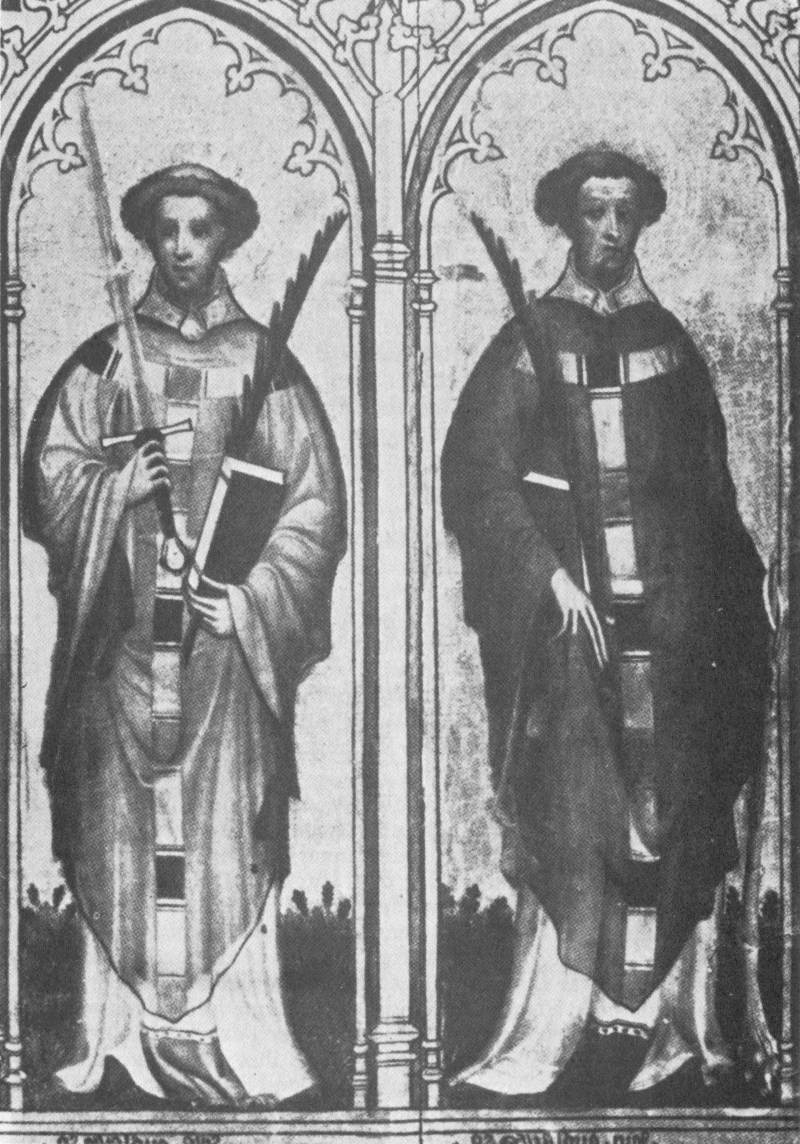by Kim Rendfeld
How could two Northumbrian priests be considered such a threat that a pagan mob would murder them?
The seventh century martyrdom of Saints Ewald the Fair and Ewald the Black in Saxony leaves a lot of unanswered questions, but their story could have been in Charlemagne’s mind as he started a series of wars against pagan Saxon tribes almost 80 years later, and those wars would result in the obliteration of the Continental Saxons’ religion.
 |
| An image of the Ewalds from 1400 |
Whether or not they accompanied Willibrord to the Continent, the Ewalds began their mission about the same time, around 690. About five years later, their journey took them to the house of a steward of a Saxon nobleman in Westphalia. The priests said they had an important message to give the aristocrat, and the steward promised to take them to him.
For some reason, the priests had to wait several days and were the steward’s guests. With their tonsures and robes, they would have already stood out, and they held Masses, prayed often, and did whatever else their faith required.
Did the practice of their religion also include preaching, with a call to destroy sites sacred to the pagan villagers? On the North Sea island of Fositeland (Heligoland), the Ewalds’ contemporary Willibrord insulted the pagans by baptizing people at a fountain holy to them and having sacred cattle slaughtered for meat.
In Germanic religions, the stakes were higher than hurt feelings. The gods held power over every aspect of their lives, from the farm fields to the battlefield. Angry gods could cause famine or defeat in battle.
The story goes that Saxon villagers believed the priests were trying to convert their chieftain and destroy their temples, and if we are to read between the lines, they thought the aristocrat could be swayed. In those days, religion was not merely a personal matter. The reason priests tried to convert a lord is that his followers might also renounce their gods and embrace Christianity.
Perhaps the people who attacked the priests feared disaster. They killed Ewald the Fair with a sword and tortured and dismembered Ewald the Black, who was the spokesman. The two bodies were thrown into a river.
When the nobleman found out about the deaths, he was furious. He ordered the murderers to be killed and the village to be burned. Was the nobleman outraged that guests in his house, and therefore under his protection, had been slain (never mind his obligation to protect the village)? Or is this element included to give the audience a sense of justice, important to Germanic societies? I leave that up to the readers. As I do the stories of the miracles that followed.
A spring of water gushed from the site where the priests had been martyred. The bodies were carried for 40 miles upriver to where the priests’ companions were, and a bright pillar of light shone above the martyrs. One of the Ewalds appeared to a monk and told him how to find the bodies.
| A 19th century illustration of the destruction of the Irminsul |
In 772, he led an army that destroyed the Irminsul, a pillar sacred to the Saxon peoples. It was the start of decades of bitter warfare, with brutality on both sides. But in the end, the thing the murderous Saxon mob feared came to pass: their religion was lost.
Public domain images via Wikimedia Commons.
Sources
"Sts. Ewald" by Columba Edmonds, The Catholic Encyclopedia
Alcuin’s The Life of Saint Willibrord
Carolingian Chronicles, which includes the Royal Frankish Annals and Nithard’s Histories, translated by Bernard Walter Scholz with Barbara Rogers
Teutonic Mythology, Volume 1, Jacob Grimm
Kim Rendfeld’s latest release, The Ashes of Heaven’s Pillar (2014, Fireship Press), starts in 772 with Charlemagne’s first war in Saxony and is told from the perspective of a Saxon peasant who will go to great lengths to protect her children.
To read the first chapters of Ashes or Kim’s debut, The Cross and the Dragon (2012, Fireship Press), or learn more about her, visit kimrendfeld.com or her blog Outtakes of a Historical Novelist at kimrendfeld.wordpress.com. You can also like her on Facebook at facebook.com/authorkimrendfeld, follow her on Twitter at @kimrendfeld, or contact her at kim [at] kimrendfeld [dot] com.
Kim's book are available at Amazon, Barnes & Noble, and other retailers.



No comments:
Post a Comment
Note: Only a member of this blog may post a comment.